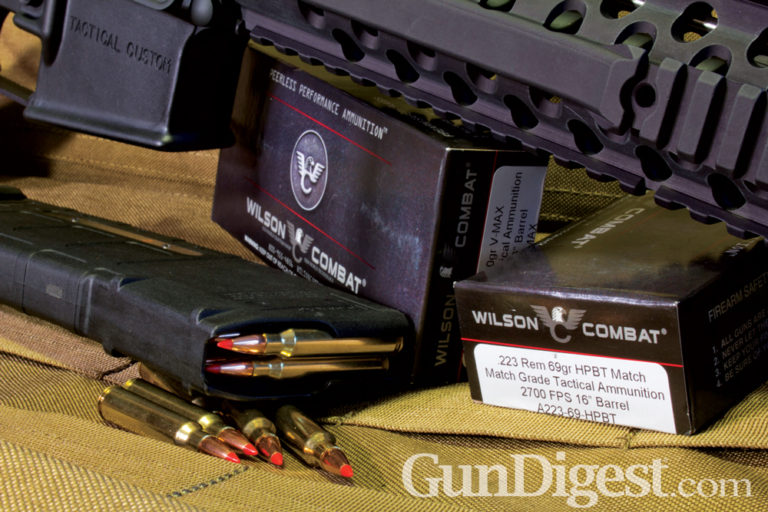
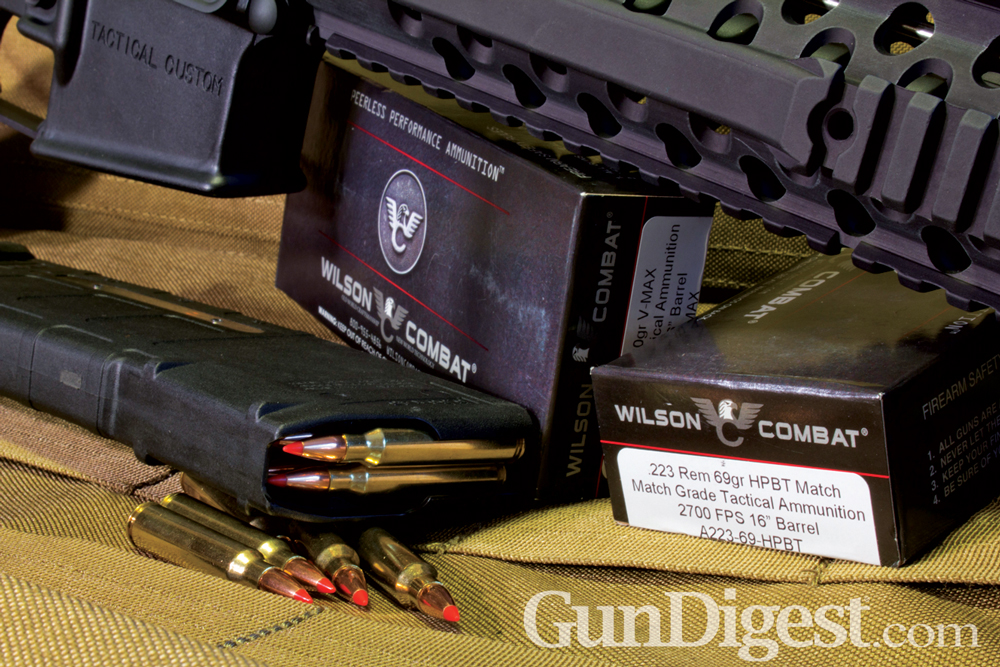
AR-15 Ammo Continually Evolving
More often than not, in the world of new cartridges, someone who has a fanciful idea to reach a new ballistic plateau comes up with a cartridge, and then gunmakers respond in kind with firearms adapted or designed around the new round. Quite often, the evolution is parallel.
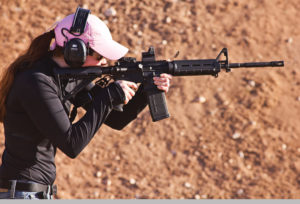
The .500 Smith & Wesson and the X-frame revolver are good examples; the pair was conceived and born together. But the AR-15, more than any other rifle in history, has broken that mold and reversed the development path of norm. In the last decade especially, a plethora of new cartridges have appeared that were designed just for the AR-15.
Quite a lot of the rounds came from military ballisticians and ammunition companies trying to improve on the 5.56X45mm NATO’s battlefield lethality—or lack thereof. Long-range shooters and competitors also sought to improve on the much-maligned 5.56, those marksmen seeking a projectile fired from that particular rifle that had enough gas to stay supersonic longer and slip the wind better.
Hunters, too, are using the AR-15 to tackle any and all of North America’s small and big game, and still another set of developmental talent wanted to give shooters the option to tackle big game or stop a vehicle or boat in its tracks via big-bore hunting and interdiction rounds. It seems the only limit for engineers, ballisticians, wildcatters, hunters, and shooters has ben making a new round fit in the rifle’s magazine—and it is amazing what will fit in an AR magazine.
One of the reasons the AR-15 has proven so popular with shooters and spawned this new crop of purpose-built cartridges is the gun’s inherent ability to easily adapt to just about any military or police, hunting, shooting, or competition mission. With a steady trickle of improvements since the rifle’s adoption by the U.S. military in the early 1960s, the AR-15 has evolved into a rifle that is extremely reliable, accurate and, most importantly, adaptable. The rifle’s relatively simple design also made it a natural platform for experimentation.
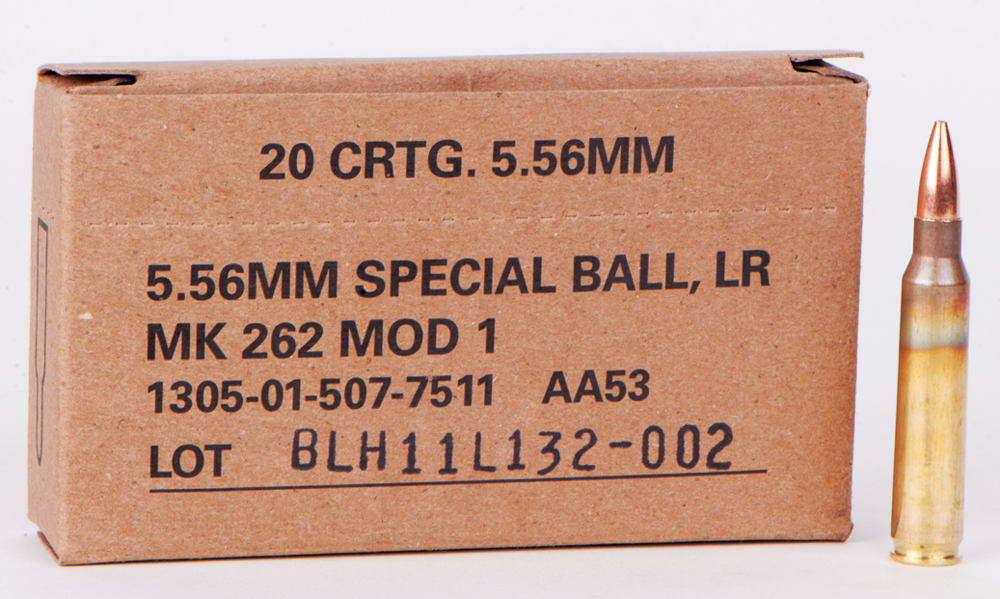
5.56X45mm NATO
It might seem odd to include the 5.56 NATO here, since it is the most popular AR-15 cartridge and the current military chambering, but the round has undergone considerable changes since its adoption. There are essentially two classes of this cartridge. The first and original class features light bullets like the 55-grain found in the M193 round. The second, epitomized by the Mk 262, Mod 0, and Mod 1 rounds developed by Black Hills, uses heavier bullets for long-range, precision shooting.
Built for the U.S. Navy’s Mk 12 SPR and now coveted by snipers and designated marksmen using similar rifles, the Mk 262’s 77-grain Sierra MatchKing projectile has a listed effective range of 600 yards, though it has certainly been put to use at longer ranges. It achieves velocities around 2,750 feet per second (fps) from 18-inch barrels and benefits from advanced propellants. Hornady loads a 75-grain hollowpoint boat-tail bullet in its .223 TAP line with similar specs.
Slower 1:7 twist rates are required to stabilize the heavier/longer bullets. Once they strike soft tissue, the bullets yaw and usually fragment to some degree, greatly increasing lethality over that of the more widely issued rounds like the M855 62-grain Penetrator or Green Tip. Serendipitously, the bigger bullets also perform quite well at close-quarters distances, when fired from short-barreled rifles like the Mk 18 (10.3-inch barrel) fielded by entry teams.
Shooters of all types have benefited from the military’s extensive efforts to improve on the 5.56mm NATO round, and now we have ammo options that extend the range and increase accuracy and lethality.
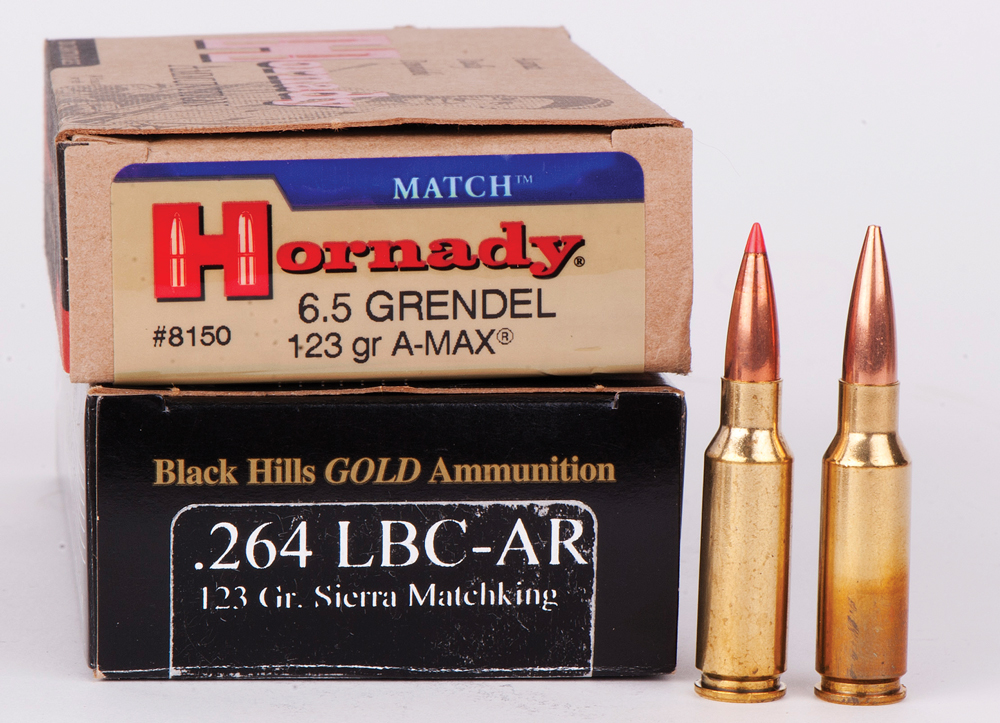
Intermediate Cartridges
The most obvious way to improve lethality or increase a rifle’s maximum effective range is to use a larger cartridge, but that usually calls for a bigger rifle. It’s easy enough to lengthen a commercial rifle’s receiver a fraction of an inch, but, with several million M-16 and M-4 rifles on hand, those hoping to get into the military supply chain needed to do so with a round that fit in a standard Mil-Spec magazine. That set a lot of talented designers and ballisticians to work and produced a whole gaggle of really clever, useful cartridges.
Probably the most successful and popular round is the 6.8mm Special Purpose Cartridge. After the 5.56’s lackluster performance in Afghanistan, in 2001, U.S. Special Operations Command shooters worked to come up with something better that still worked in an M4. They did some experimentation with PPC cartridges, but designers finally settled on the obsolete .30 Remington case, because of its smaller rim diameter. There was enough case capacity to push 110- and 115-grain bullets to velocities substantially beyond what the 7.62X39mm could produce with 123-grain FMJ bullets. Swapping calibers was an armorer-level job that required only a barrel, bolt, and magazine change.
The 6.8mm SPC worked like a charm for close- and long-range engagements, producing far better results than that experienced with the 5.56 mm. Why the round was not adopted by units outside of SOCOM is anyone’s guess. Several U.S. manufacturers started producing commercial ammunition with open-tipped match, polymer-tipped, and hunting bullets, and nearly every AR manufacturer soon had a 6.8 in their catalog. Hunters have found the round perfect for whitetails and other medium-sized game, when the shots fall inside 300 yards. And, while the 6.8 mm SPC is not the U.S. Military’s next service round, it is now firmly entrenched in the AR-15 shooting community.
The round is now the second-most popular AR-15 chambering.One of the more versatile intermediate rounds is the 6.5 mm Grendel developed by Bill Alexander, of Alexander Arms. He took a 6mm PPC case, shortened the neck, moved the shoulder forward, and increased the diameter to take advantage of all those 6.5mm bullets with their superb ballistic coefficients. The end result is a cartridge that can better the 5.56 NATO—or 7.62 NATO for that matter—in just about every category. The Grendel is also a capable competition round, one with the reach to compete at the 1,000-yard line, something the 6.8 mm SPC cannot do. With properly constructed bullets, it is a great varmint or medium-game hunting round.
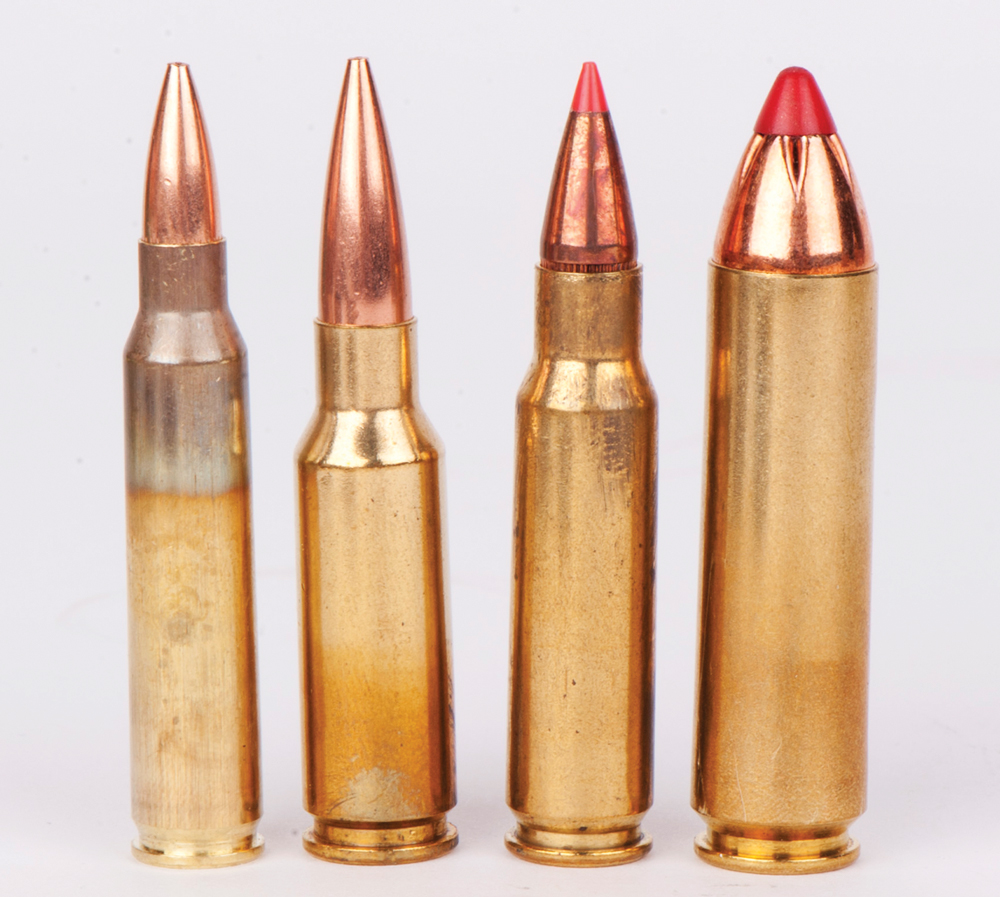
Factory ammunition runs from 90 to 130 grains and is loaded by Hornady, Alexander Arms, Wolf, and Black Hills, though the latter is headstamped .264 LBC-AR. Alexander Arms recently relinquished the trademark claim, which recently lead to the Grendel’s SAMMI standardization, which should open the doors for more companies to produce ammunition.
Americans have an affinity for anything .30-caliber, so it was a foregone conclusion a .30-caliber cartridge for ARs would eventually make an appearance. Actually, several .30-caliber AR cartridges have burst onto the scene recently, including the .300 Blackout, 7.62X40mm Wilson Tactical, and .30 Remington AR.
The .300 Blackout and 7.62X40mm WT both are based on 5.56 NATO brass and are loaded with a variety of bullets suited to a variety of tasks. The concept is an old one and was standardized to a degree by J.D. Jones, of SSK Industries, who used .221 Fireball brass and trademarked the .300 Whisper.
The Blackout and Whisper are interchangeable to a degree, with Blackout rounds firing safely in Whisper chambers. In short-barreled PDWs (personal defense weapons) the .30-caliber bullet is much more effective than either 5.56 or 9 mm bullets. When fired through 16-inch barrels, the cartridges make fine hunting rounds, with minimal recoil and reasonable trajectories out to 200 yards.
A cartridge originally built for SOCOM/JSOC units, the Blackout is also loaded with 208- and 220-grain bullets that never break the sound barrier. The two vastly different bullet weights allow operators to initiate ambushes or handle sentry duty quietly, before swapping magazines to go head-to-head with AK-47s at ranges beyond 300 yards—with a rifle that has a nine-inch barrel.
In the world of AR cartridges, the .30 Remington AR is one of the few not conceived with martial aspirations. It was designed from the start by Remington engineers as a hunting cartridge, a way to fit .308 Winchester performance into an AR-15 and avoid the less svelte AR-10. This round essentially picks up where the 6.8mm SPC left off, able to achieve around 2,750 fps with 123- and 125-grain bullets from 22-inch barrels. The cartridge is a handloader’s dream and a favorite of this edition’s editor. In fact, Richard Mann puts the .30 RAR in a class by itself, deeming it one of the best AR hunting cartridges extant.
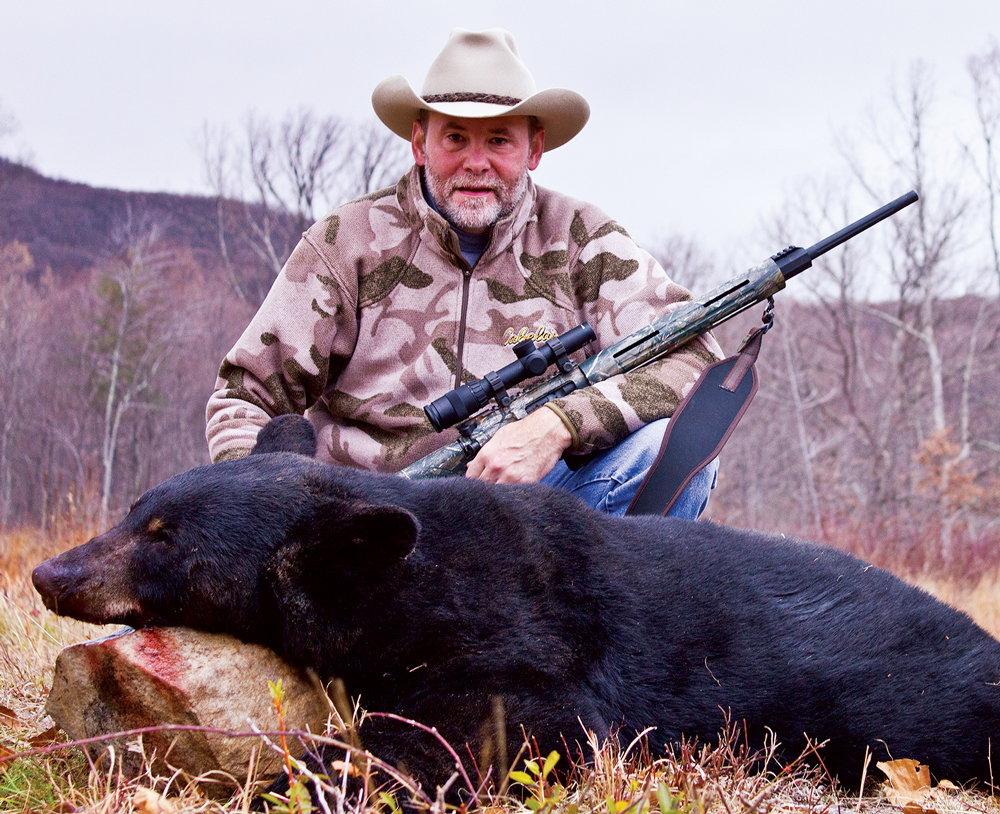
Big-Bore ARs
At varying points in the last decade, several enterprising souls looked into an AR magazine and thought to fill it up completely with one massive cartridge instead of a couple little ones. The resulting cartridges—the .450 Bushmaster, .458 SOCOM, and .50 Beowulf, among others—are big league heavy hitters.
They all use a rebated rim to fit inside a standard AR bolt head and generally run at pressures well below that of the 5.56mm. The only real concern with fitting cartridges of this size in an AR resides in the bolt thrust and making sure the gas port is both the right size and sits in the right place for reliable function. All three rounds obviously produce substantially more recoil than 5.56mm rifles, but the rifle seems up to the task. (Scope mounts are another matter.)
Rifle manufacturers seem to have divvied up the calibers between themselves, with Rock River Arms building .458 SOCOM rifles, Bushmaster producing the .450 Bushmaster, and Alexander Arms building rifles chambered for the cartridge it invented. Ammunition is a little hard to find and, in some cases, expensive, but available. Reloaders usually prefer the SOCOM over the Bushmaster and Beowulf, because the wider selection of available bullets.
The .458 and .50 were envisioned as interdiction and barrier-beating rounds for stopping cars at roadblocks and ventilating two-legged predators hiding behind cinderblock walls and the like. It seems most shooters use these big-boress to turn mobile pork into stationary pork. The rounds are also ideal for close-range bear hunting or hitting anything with bullets weighing in excess of 250 grains and moving over 2,000 fps. Most Beowulf loads produce over 2,900 foot-pounds (ft-lbs) of muzzle energy.
Imagine the possibilities of combining one of these big-bore cartridges loaded with good, solid bullets and a lightweight AR carbine fed from a high-capacity detachable magazine. Pair the rifle with a weapons light and a 1X-optic like an Aimpoint, Trijicon, or EOTech, and you might have the perfect guide’s gun for backing up hunters or tracking wounded bears in Alaska. It weighs less, provides more firepower, and permits faster follow-up shots than most other rifle actions.
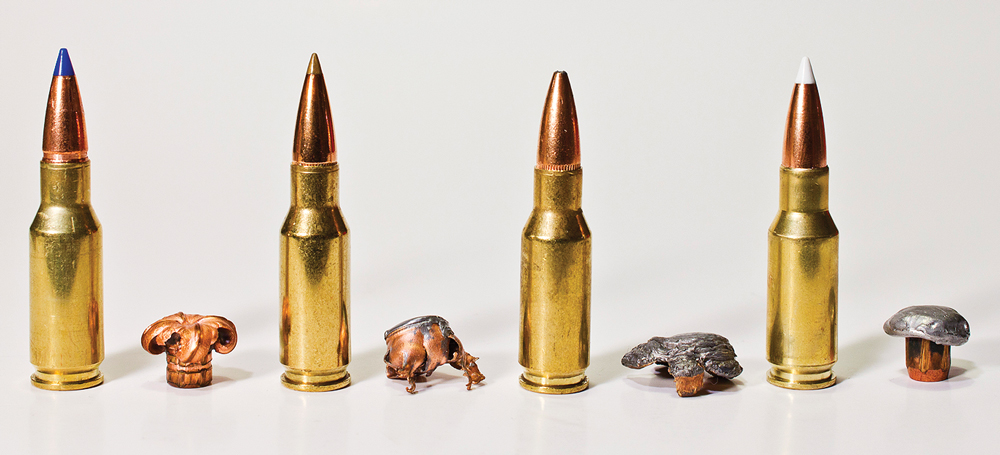
The Future
This chapter honestly just scratches the surface of AR cartridges and has covered some of the more common factory chamberings specifically designed around the AR-15. Nearly anything that could squeeze its way through the magazine well has been tried, including the Winchester Super Short Magnums. The 13th Edition of Cartridges of the World has several new AR-15 cartridges like the .358 Gremlin, which are designed specifically to meet the state of Indiana’s centerfire rifle deer hunting restrictions.
And you can bet the 14th Edition will have even more. Heck, bolt-action uppers chambered for .50 BMG are available for the truly adventurous AR-15 owner. Who knows what else is to come?
As propellant and bullet technologies advance, expect to see has-been cartridges revisited and revamped. Somewhere, someoner will need a round tailored to a very specific purpose, and it is very likely an AR-15, M-16, or M-4 will be able to chamber that round and get the job done better than any other rifle around. All that is needed is for some enterprising wildcatter to step up and design the next best thing.
This article appeared in the Gun Digest the Magazine 2013 Shooter's Guide.

Next Step: Get your FREE Printable Target Pack
Enhance your shooting precision with our 62 MOA Targets, perfect for rifles and handguns. Crafted in collaboration with Storm Tactical for accuracy and versatility.
Subscribe to the Gun Digest email newsletter and get your downloadable target pack sent straight to your inbox. Stay updated with the latest firearms info in the industry.

![Best Concealed Carry Guns In 2025 [Field Tested] Wilson Combat EDC X9S 1](https://gundigest.com/wp-content/uploads/Wilson-Combat-EDC-X9S-1-324x160.jpg)


![Best 9mm Carbine: Affordable PCCs [Tested] Ruger Carbine Shooting](https://gundigest.com/wp-content/uploads/Ruger-Carbine-Shooting-100x70.jpg)
![Best AR-15: Top Options Available Today [Field Tested] Harrington and Richardson PSA XM177E2 feature](https://gundigest.com/wp-content/uploads/Harrington-and-Richardson-PSA-XM177E2-feature-100x70.jpg)

“Slower 1:7 twist rates” – quite certain you meant either ‘slower velocity bullet’ or ‘faster 1:7 twist rates’. Obviously a 1:7 twist rate is faster than a 1:9 twist rate and will produce more rotation. Longer bullets generally need a faster twist rate to properly stabilize.
There is a concerted ongoing effort to “sell” the 5.56. An effort to get the 5.56 to do what it is not cable of doing. If the platform, such as the AR and its variants was not so versatile, the AR in 5.56 would be a dying breed. It is the flexibility of the AR and not the 5.56 that sells the firearm. This is the bottom line. If you are engaging targets at 500 to 600 yes, are you seriously going to rely on 5.56? Of course not, so why push an inadequate round, except to make money. . There is a big difference between hitting the bulls eye on a paper target at 500 yds, and killing the enemy at 500 yds. If you are hooked on the AR, which is a good weapon, and want to engage real targets at extended range at least rebarrel the weapon. No firearm is the ideal for all missions and conditions, so base weapon selection on the mission, and not hype from folks with a financial angle. And one last thing, in what states is it legal to take big game with 5.56 as the author states?
Texas and Oklahoma are two that I know of that allow 223 to be used for deer. Oklahoma requires a 7 round or less magazine in the 223. If the ar is of the 308 variety you can used the 20 round magazine.
If you’re sticking to .223/5.56 mm, consider rounds that use Barnes TSX copper bullets. Black Hills makes loadings in both .223 and 5.56 mm, the latter to NATO and military specs, sealed, low flash powder and all that. They also sell to us their MK262 Mod 1 that you mention.